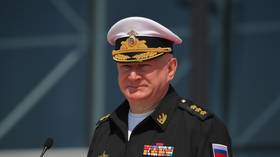New Russian frigates will be armed with hypersonic missiles – Navy head

All new Russian navy frigate and corvette class vessels will be equipped with hypersonic Zircon missiles, Chief Admiral Nikolay Yevmenov announced on Thursday. He did not, however, reveal the exact number of warships the navy expected to receive the weaponry.
“All the ships of the frigate class that are under construction or are being laid down will be armed with ‘Zircons’,” he told RIA Novosti on the sidelines of the International Maritime Defense Show (IMDS) in Russia’s Kronstadt. “Corvettes [will get them] too,” he added.
Zircon missiles were brought into service early this year. The projectiles are said to be much faster than any previously developed Russian anti-ship missiles and those used by NATO nations.
In 2019, Russian President Vladimir Putin said in his annual address to parliament that Zircon missiles would be able to hit targets at a range of 1,000 kilometers (621 miles) while flying nine times faster than the speed of sound. The Tomahawk and Harpoon missiles used by the US Navy are both subsonic.
The Zircon can be used against any surface vessels, ranging from frigate to aircraft carrier, as well as any land targets.
The decision does not mean that Russia plans to abandon its Kalibr and Onyx cruise missiles, which are also actively used by the navy, Yevmenov said. Both missiles have previously demonstrated “high reliability,” he added.
A P-800 Onyx missile can travel at speeds of up to 2,700 kph (1,700 mph) and hit warships of any class. It can engage its targets at a range of up to 300 kilometers (186 miles) depending on the projectile’s trajectory. Although designed to be deployed against ships, it can be used against ground targets as well.
Earlier this week, Yevmenov said that the military operation in Ukraine shows the need for Russia to enhance its navy “now.” All the best innovative ideas should be put into practice right away, the admiral argued, calling for the design and development phases to be shortened for new projects.
The navy chief also revealed that Russia’s defense industries plan to enhance their shipbuilding capabilities. This year alone, the Russian Navy expects to receive 44 new ships, including both warships and support vessels.
Putin also said this week that a further strengthening of the Russian Armed Forces remains one of the country’s top priorities. Apart from Zircon missiles, the navy is expected to receive new Borei and Borei-A nuclear-capable submarines, which are equipped with 16 intercontinental ballistic missiles each as part of these efforts, the president added.













